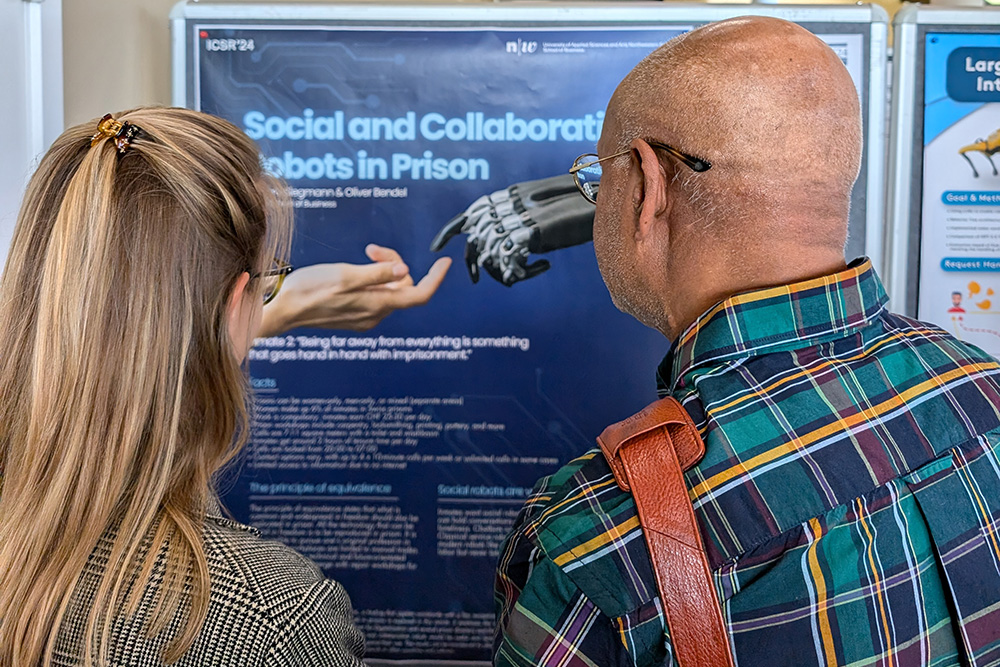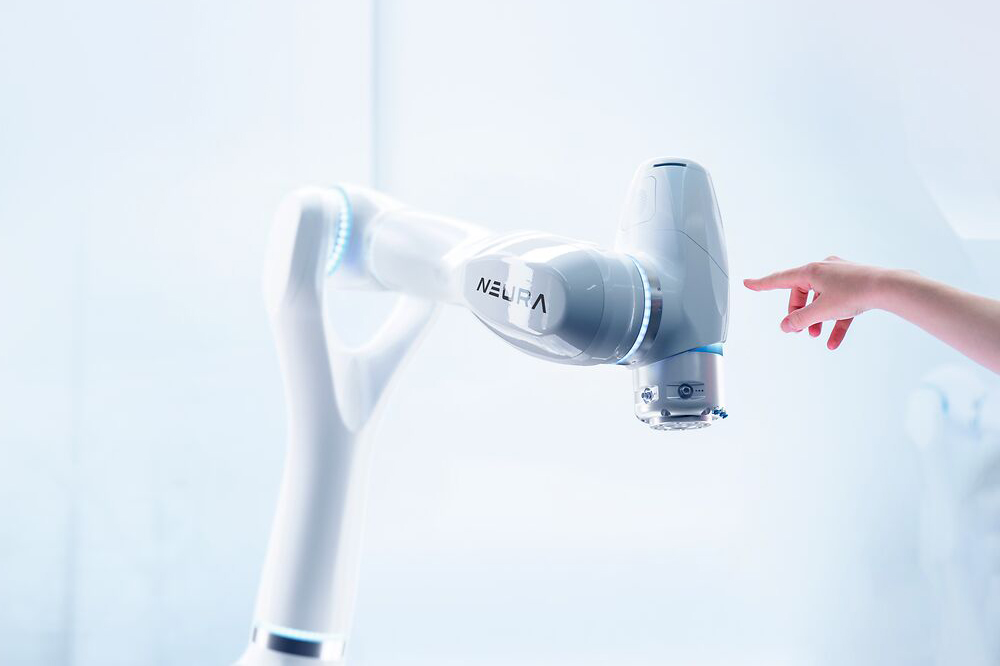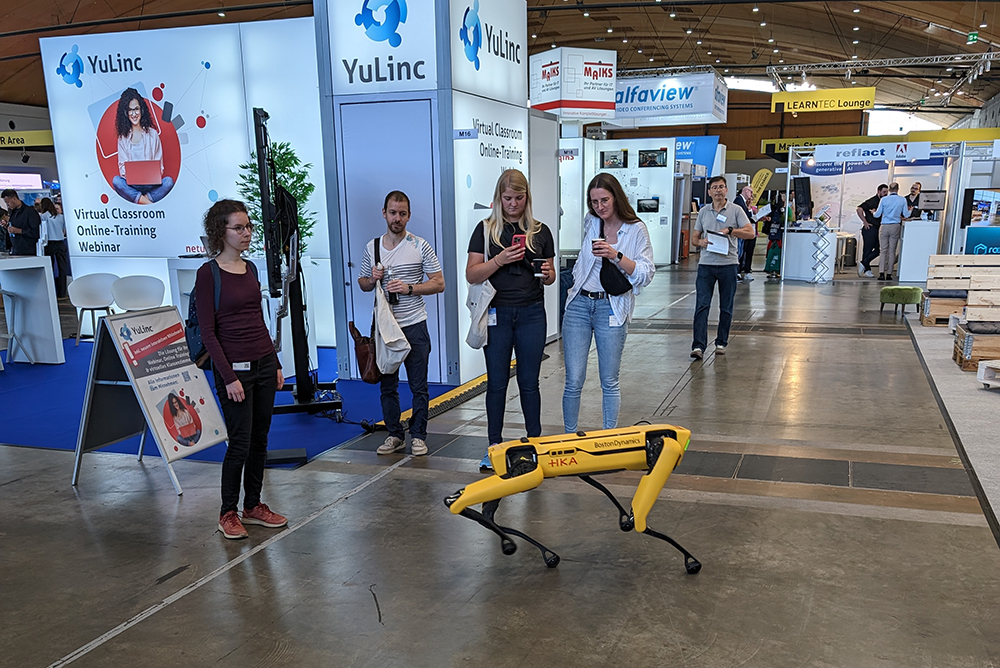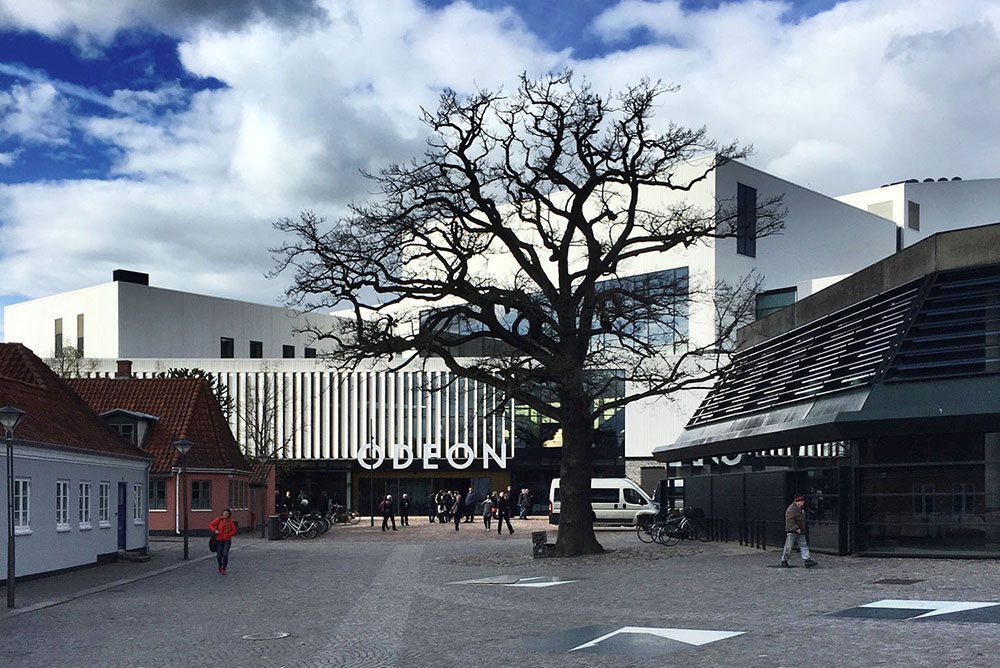From April 15 to 17, 2025, the elective module “Social Robots” once again took place at the FHNW School of Business – as it has so often since 2021. The participants were information systems students from various locations. And once again, a GPT specialized in the topic was available, namely Social Robotics Girl. Prof. Dr. Oliver Bendel repeatedly had her explain the facts and then made additions. She also asked questions to the audience and provided a few laughs with her competent and nerdy manner. The robots at the demo included Unitree Go2 (called Bao), Pepper, Alpha Mini, Booboo, Furby, Cozmo, and Aibi. With the exception of Pepper, they all come from the Social Robots Lab, which is privately funded by Prof. Dr. Oliver Bendel. Unitree Go2 was used to explore not only the seminar room on the Olten campus, but also the area in front of it. The robotic four-legged friend ran forwards and backwards, jumped, stood on its hind legs, drew a heart in the air, and impressed with various dance interludes. When designing their own social robots – the students complete this task in groups – they again worked with the five-dimensions model by Oliver Bendel and image generators.
Apollo Comes to Berlin-Marienfelde
According to a press release from March 18, 2025, Mercedes-Benz is bringing one of “the most advanced commercial humanoid robots in the world” (Mercedes-Benz press release, own translation) to Berlin-Marienfelde. This site has established itself as a global competence center for production digitization since the launch of the Mercedes-Benz Digital Factory Campus (MBDFC) in 2022. The manufacturer, Apptronik, is based in Austin and was founded in 2016 as a spin-off from the Human Centered Robotics Lab at the University of Texas. According to its website, Apollo is “the first commercial humanoid robot that was designed for friendly interaction, mass manufacturability, high payloads and safety” (Apptronik website). The robot stands approximately 172 cm tall and weighs about 72 kg. Unlike comparable bipedal robots, it does not have a display in the facial area, but only two eyes. Its head resembles that of social robots such as ARI or P-Care. Apollo is a modular system that can be used either in a stationary or mobile setup. Regarding its implementation, Mercedes-Benz states in the press release: “The Apollo robots have collected data in a production environment in order to train for specific use cases” (Mercedes-Benz press release, own translation). Employees with hands-on production experience at Mercedes-Benz “transferred their knowledge to Apollo using teleoperation processes and augmented reality” (Mercedes-Benz press release, own translation). “Now, Mercedes-Benz is taking the next crucial development step at the MBDFC in Berlin: The Apollo robots are learning to operate autonomously – a technological milestone on the path to a flexible, intelligent assistance system for production” (Mercedes-Benz press release, own translation).
A Truck Tire for the Police
China’s latest crime-fighting innovation is RT-G, an AI-powered spherical police robot that not only stops crime, but somehow detects it. “Developed by a Shenzhen-based robotics company Logon Technology, the bot robocops are engineered to assist law enforcement in high-risk situations and, eventually, replace human officers in the line of fire.” (Firstpost.com, 12 December 2024) This was reported by the Indian platform Firstpost.com under the title “Meet RT-G, ‘spherical’ robot that is helping China to tackle crime”. According to The Sun, the spherical robot can operate on both land and water, and is able to withstand rough terrain and mud with ease. In some pictures, the robot looks as futuristic and attractive as BB-8’s body, in others like the clumsy tire of a truck or a bus. Whether such a model will be widely accepted by the population is questionable. But perhaps that’s not the point. Like Spot, RT-G is perhaps intended to create uncertainty. Something like this is more likely to harm robotics.
Trump is Guarded by Spot
Spot from Boston Dynamics is the latest tool in the arsenal of the US Secret Service. This was reported by the BBC on November 17, 2024. The robot was recently spotted patrolling the perimeter of President-elect Donald Trump’s Mar-a-Lago resort in Palm Beach, Florida. As the video on the website shows, they do not carry weapons; “and each can be controlled remotely or automatically – as long as its route is pre-programmed”. Passers-by are warned by a sign on each of Spot’s legs that reads, “DO NOT PET”. “I don’t know that anyone would be tempted to pet these robot dogs. They do not look cuddly,” Melissa Michelson, a political scientist at Menlo College, told the BBC. Oliver Bendel, an expert in social robotics at the FHNW School of Business, disagrees. He has been working with Unitree Go2, which is half the weight and smaller than SPOT but otherwise comparable, since 2023. “The students are initially amazed or shocked when they see it. After a minute or two, their doubts are dispelled and they try to lure it in and stroke it.” A robot like Spot is well suited to an estate like Mar-a-Lago. However, models such as K5 from Knightscope or RBwatcher from Robotnik/URG can also be used on the lawns.
Robots in Prison
On October 22, 2024, Tamara Siegmann and Prof. Dr. Oliver Bendel (School of Business FHNW) presented their project “Robots in Prison” at the ICSR in Odense (Denmark). They investigated whether collaborative and social robots can and should be used in prisons. One result was that modern industrial robots such as cobots and classic service robots such as transportation and cleaning robots hardly create any added value. Instead, they take work away from inmates. In contrast, social robots are conceivable and useful. They bring something to imprisonment that is common in freedom. And – an important point for resocialization – they can combat the loneliness of inmates. The International Conference on Social Robotics is the most important conference for social robotics alongside Robophilosophy. The paper “Social and Collaborative Robots in Prison” will be published in a proceedings volume by Springer at the end of the year.
Robotics in Retail
September 25, 2024 was the first day of the AI & Robotics4Retail Conference 2024 in Bonn. It was part of the “ECR Day 2024”, which took place at the World Conference Center. Numerous practical presentations provide an insight into the most important AI and robotics topics in retail at the moment and provide important ideas for projects in your own company, according to the website. The keynote speech was given by Prof. Dr. Oliver Bendel on the topic of “Service robots from a technical, economic and ethical perspective”. From the description: “Service robots have become widespread as cleaning, transportation, and security robots. As vacuum and mopping robots, they can be found in households, airports and hotels. As transport robots, they move around factories and warehouses, move between the buffet and kitchen in restaurants or bring orders to customers in cities. In the form of social robots, they advise and serve us in shopping malls or entertain our children while we shop. Universal robots, human-like machines that help in production and logistics in the morning, dig up the garden in the afternoon and play tennis with us in the evening, are just around the corner. They are connected to multimodal language models that enable or improve their control and perception. The talk presents use cases of this kind, classifies them from a technical, economic and ethical perspective, and takes a look into the future.” Further information about www.robotics-konferenz.de.
A Cobot as Conductor of a Symphony
Cobots that dance with humans have been around for a long time. In 2016, the audience at Südpol Luzern witnessed dance and robot history being written by Huang Yi, a choreographer from Taiwan. Cobots that set the pace for humans, on the other hand, are not yet the order of the day. The Dresden Symphony Orchestra is about to perform the “Roboter.Sinfonie”. After a while, conductor Michael Helmrath will hand over to MAiRA Pro S, a product from NEURA Robotics. According to Deutschlandfunk, the machine’s three arms will be able to guide the orchestra, which is divided into groups, through the most complex passages independently of each other. This will break completely new musical ground. According to the Dresden Symphony Orchestra’s calendar, the concerts will take place on October 12 and 13, 2024 at the Europäisches Zentrum der Künste Hellerau (Image: NEURA Robotics).
Robot Dog Neo Interferes With IoT Devices
According to a report by 404 Media on 22 July 2024, the Department of Homeland Security (DHS) has acquired and modified a dog-like robot called NEO. This robot, equipped with an antenna array, can overload home networks to disable Internet of Things (IoT) devices during law enforcement operations. Benjamine Huffman, director of the Federal Law Enforcement Training Centers (FLETC), revealed the details at the 2024 Border Security Expo. NEO, a modified version of Ghost Robotics’ Vision 60 quadruped unmanned ground vehicle (Q-UGV), helps disable potentially dangerous smart home devices that could be used as booby traps. This development follows an incident in 2021 in which a suspect used a doorbell camera to spy on FBI agents and shot at them, killing two agents. The DHS has also created the ‘FLETC Smart House’ to train officers on how to deal with IoT devices that could be used against them. Robotic pets are becoming increasingly popular with homeland security agencies and police forces. Boston Dynamics’ Spot is used on patrols in New York City and Germany.
Deadline for ICSR 2024 Extended Again
The deadline for the International Conference on Social Robotics 2024 (ICSR 2024) has been extended again. Experts in social robotics and related fields have until July 19 to submit their full papers. The prestigious event was last held in Florence (2022) and Qatar (2023). Now it enters its next round. The 16th edition will bring together researchers and practitioners working on human-robot interaction and the integration of social robots into our society. The title of the conference includes the addition “AI”. This is a clarification and demarcation that has to do with the fact that there will be two further formats with the name ICSR in 2024. ICSR’24 (ICSR + AI) will take place as a face-to-face conference in Odense, Denmark, from 23 to 26 October 2024. The theme of this year’s conference is “Empowering Humanity: The role of social and collaborative robotics in shaping our future”. The topics of the Call for Papers include “collaborative robots in service applications (in construction, agriculture, etc.)”, “Human-robot interaction and collaboration”, “Affective and cognitive sciences for socially interactive robots”, and “Context awareness, expectation, and intention understanding”. The general chairs are Oskar Palinko, University of Southern Denmark, and Leon Bodenhagen, University of Southern Denmark. More information is available at icsr2024.dk (Photo: Jacob Christensen).
GXO Signs Agreement with Agility Robotics
“GXO Logistics, Inc. (NYSE: GXO), the world’s largest pure-play contract logistics provider, and Agility Robotics, creator of the leading bipedal Mobile Manipulation Robot (MMR) DigitⓇ, announced today that they have signed a multi-year agreement to begin deploying Digit in GXO’s logistics operations. This agreement, which follows a proof-of-concept pilot in late 2023, is both the industry’s first formal commercial deployment of humanoid robots and first Robots-as-a-Service (RaaS) deployment of humanoid robots.” (Press Release, 27 June 2024) This was announced by Agility Robotics in a press release dated June 27, 2024. “Digit is a multi-purpose, human-centric robot made for logistics work, and designed to work safely in human spaces and help with a variety of repetitive tasks. Agility Arc is designed to simplify the deployment lifecycle, from facility mapping and workflow definition to operational management and troubleshooting.” (Press Release, 27 June 2024) According to Oliver Bendel, Digit, Atlas, Figure 01, H1, G1, and other models can be seen as preliminary stages of universal robots. It is important to test them in closed or semi-open worlds such as factories before releasing them into open worlds (Photo: Agility Robotics).









